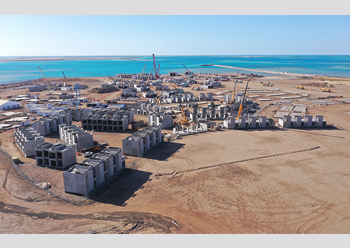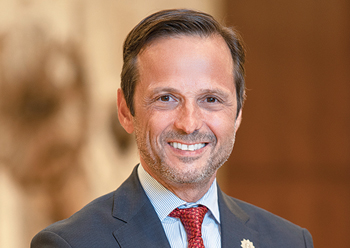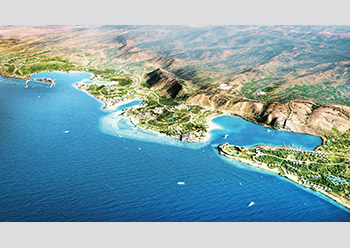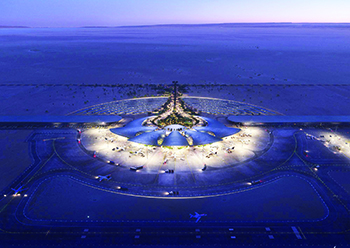
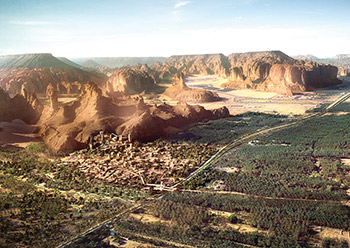 A panoramic view of the Dadan area envisaged in the masterplan.
A panoramic view of the Dadan area envisaged in the masterplan.
An ambitious plan to transform AlUla historical region into “the world’s largest living museum” was kick-started with the launch of a masterplan known as ‘The Journey Through Time’ by Saudi Arabia’s Crown Prince Mohammed bin Salman last month.
Following the launch, the massive regeneration project announced $15-billion worth of opportunities for responsible investment in public-private partnership projects in the masterplan.
The Journey Through Time masterplan, a roadmap to protect 200,000 years of natural and human history across the 20-km-long core historical area of AlUla, is anchored by the regeneration of five heritage districts. The first in a series of masterplans for AlUla, it includes 15 new cultural assets, a 9-km rejuvenated Cultural Oasis, 10 million sq m of green and open spaces, and a 46-km low-carbon tramway, while contributing to AlUla’s hospitality offer with 5,000 additional hotel keys.
Located 1,100 km from Riyadh in northwest Saudi Arabia, AlUla is a place of extraordinary natural and human heritage. The vast area, covering 22,561 sq km, includes a lush oasis valley, towering sandstone mountains and ancient cultural heritage sites dating back thousands of years. The most well-known and recognised site in AlUla is Hegra, Saudi Arabia’s first Unesco World Heritage Site. A 52-hectare ancient city, Hegra was the principal southern city of the Nabataean Kingdom and comprises nearly 100 well-preserved tombs with elaborate facades cut into sandstone outcrops.
 |
|
Dadan district... eyeing potential developers. |
CEO Amr AlMadani said: “With an estimated total development value of over $15 billion, The Journey Through Time masterplan is an important opportunity to showcase AlUla’s full potential. By de-risking investment opportunities through our $2 billion seed funding and creating a robust governance framework, we have created a platform for responsible and sustainable development to regenerate a unique location featuring a Unesco World Heritage Site.”
An estimated $3.2 billion will be injected into developing AlUla’s priority infrastructure. A key component to unlocking AlUla’s future as a sustainable development destination, this will include a 46-km low-carbon tramway (22 km for the first phase) and increasing clean power capacity, with at least 50 per cent of demand supplied through renewable energies by 2035.
The plans also include increasing potable water capacity, with a centralised and upgraded water supply system including a new water supply of desalinated water and a tailor-made water conservation programme; and increasing wastewater capacity with an upgrade of the wastewater treatment plant in Mughayra.
According to the Royal Commission for AlUla (RCU), work has already begun across all sectors of AlUla’s development: community, arts and culture, heritage and archaeology, nature and wildlife, agriculture, tourism and hospitality and infrastructure.
Once completed, it will see the establishment of five unique districts in the heart of AlUla, from Old Town in the south to Hegra Historical City in the north, each shaped by the site’s natural and cultural heritage. Each of the districts – AlUla Old Town, Dadan, Jabal Ikmah, Nabataean Horizon and Hegra Historical City –will focus on an existing heritage site and will be traversed by AlUla’s ancient oasis. The districts will cover the core historical area of AlUla, encompassing a wadi (seasonal river valley) and culminating in the Nabataean city of Hegra.
 |
|
Nabataean Distict ...one of the five unique districts in the heart of AlUla. |
Fifteen new cultural assets including museums, galleries and cultural centres will serve as landmarks across each district.
Under the masterplan, a 9-km stretch, constituting the heart of the Cultural Oasis, will be fully rejuvenated, starting in AlUla Old Town.
A 20-km-long public realm area, known as the Wadi of Hospitality, running along the ancient oasis’s bed will connect the five districts and act as the green pedestrian ‘spine’ of the masterplan.
In addition, a total of 5,000 room keys will be created, with each district set to offer its own tailored blend of living and hospitality options, ranging from hotels and eco-tourism resorts to luxury lodges and canyon farms carved into the sandstone rocks.
The 46-km low-carbon tram line will connect AlUla International Airport to the five districts. A scenic roadway as well as bicycle, equestrian and pedestrian trails will promote a smooth and experiential approach to mobility, championing low-carbon journeys.
The wadi and the low-carbon tramway will mostly follow the route used by pilgrims earlier on the Hijaz Railway for many centuries.
Contributing to the Saudi Green Initiative, the regeneration of AlUla is underpinned by a strategy to rehabilitate the land and reverse the course of desertification in the area. Enabling a major expansion of AlUla’s green and open spaces up to 10 million sq m, it will provide a haven for AlUla’s archaeological sites, an opportunity for sustainable agricultural production as well as providing a memorable experience for visitors, said the RCU.
Unveiling the masterplan last month, Prince Mohammed bin Salman said: “Today, we embark on a journey to preserve the world’s largest cultural oasis and advance our understanding of 200,000 years of heritage. The Journey Through Time masterplan is a leap forward to sustainably and responsibly develop AlUla, and share our cultural legacy with the world.”
 |
|
The tomb of Lihyan ... located in AlUla. |
He also launched two flagship projects of the masterplan – the Kingdoms Institute and the Cultural Oasis – that reflect Saudi Arabia’s commitment to offer the world a viable model for protecting, preserving and contributing to the world’s cultural and natural legacy.
Kingdoms Institute will be a global hub for archaeological knowledge and research dedicated to the cultures and civilisations that have inhabited the area for more than 7,000 years, including the ancient kingdoms of Dadan and Lihyan and the magnificent Nabataeans, who built the city of Hegra, a Unesco World Heritage Site.
According to the RCU, the Journey Through Time masterplan constitutes the first and most important part of AlUla’s development. It will be implemented in three phases until 2035, with the first phase set to be completed by 2023, aiming to provide a comprehensive visitor-centric experience.
Upon completion of the wider development strategy for AlUla in 2035, 38,000 new jobs amid a population grown to 130,000 will have been created, said the Royal Commission for AlUla.
Additionally, 80 per cent of AlUla will have been designated as nature reserves with key flora and fauna reintroduced, the RCU added.
Over the past three years, RCU has conducted other development work involving investments of $2 billion. This included expanding capacity by 300 per cent at AlUla’s international airport which has welcomed its first international flight recently, and building the 500-seat Maraya, the award-winning multi-purpose conference and entertainment venue. Additionally, previously announced signature hospitality projects include the development of luxury resorts in partnership with Accor/Banyan Tree, Habitas, and Jean Nouvel.

















.jpg)













 (1).jpg)















































